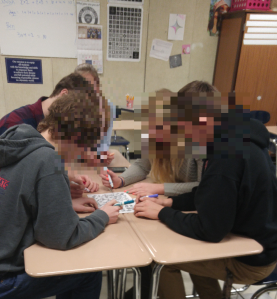For about a year now, I’ve positioned my desks in groups of four. This trimester, my largest class is 35 students, but I was determined to make the groups fit. I think I nailed it.

My room isn’t really this big. This is a panoramic photo.
For a lot of students, group work has consisted of a couple of things:
- We compare answers, but when in doubt, write down what the smart kid has.
- We work in close proximity to one another, but for the most part, individually.
I’ve been reading Jo Boaler’s new book Mathematical Mindsets which address productive group work and have also read Strength in Numbers by Ilana Horn which surrounds similar issues. (Ilana has blogged on status in math class here) Both texts highlight the importance of addressing status in the mathematics classroom. Because today was the first day of the new trimester, I thought it was a great opportunity to model and discuss what great group work looks like in order to level out the social status of students in my class.
1 – 100 Group Task (adapted from Sara Vanderwerf)

- Make sure students are in groups of 4. Groups of 3 or less should join another group and partner with another member of that group.
- Give students highlighters or markers. Make sure each group member has a different color.
- Distribute one handout per group face down.
- Have students decide who will go first and then continue in a clockwise direction.
- First student will highlight or cross off the number 1. The next student will cross off number 2. The following student 3 and so on.
- Give students a fixed amount of time (I did 2 minutes) to get as far as they can.
While students are feverishly crossing off numbers, discretely walk around and take pictures of each group as they work. Be sure to capture models of group work you would like to highlight. For example, note students helping one another find numbers. Also, include students all looking at the paper no matter whose desk it is on.
When time has elapsed, have groups make note of where they left off. I asked, “if I had you discuss strategies, would you be able to improve the number you were able to cross off?” Most will (obviously) agree, but then I give them a minute or two to examine their paper and discuss some strategies. If your students are paying close enough attention, they should notice that the numbers are divided into quadrants.

Redistribute a new sheet, face down and start the time again for 2 minutes. Again, circulate and take pictures, this time capturing the increased determination represented by putting their heads together and keeping the paper on one desk. For fun you may want them to record their new number. I had students record their number for the first round compared to the second round. We then discussed how we could rank the groups based on the results which ended in a nice conversation about rate of change. If I were more savvy, I might take the data from all three of my classes and put them on a scatterplot in Desmos to see if there is a relationship between their first round score and their second round score. Alas, that was not to be. Afterall, the purpose of the activity was not to “win.” It was to talk about what great group work looks like.
I revealed to them that while they were working I was taking pictures. I had them predict what we would see on the pictures that would demonstrate a productive group. We made sure to clarify that groups won’t always physically put their heads together to work. But that the idea of all group members focusing on the same task at hand was essential. This allowed us to lay the foundation for future meaningful group work so that the students benefit from it.



Love it , thanks!
Pingback: 100 Numbers to Get Students Talking | saravanderwerfdotcom
Pingback: Back After Break ~ Day 1 | the radical rational...
I’m borrowing this lovely activity to kick off my spring term. Couple of logistical questions/clarifications: Do the students need to go in ‘order’ at the table as the cross off numbers? If so, do you think that it matters that each student should have a different color highlighter? How long did this activity take – is there a flexible amount of time?
Pingback: The Pursuit of 100%. Practical Ideas for Engaging Students – saravanderwerfdotcom
Pingback: Making Groups Work | mho maths
I’m doing this today….it’s the first day of our new season of Math Pentathlon Club! I’m so excited, I can’t even stand it! LOVE this idea. Thank you for loving math! I’ll post pics when we’re done! Cheers from Cedar Park, TX!
Pingback: 100 Numbers to Get Students Talking - Sara VanDerWerf
Fantastic idea.
This will definitely help in settling my class into group work as I prepare to see them for the first time next week.
Thank you for sharing.